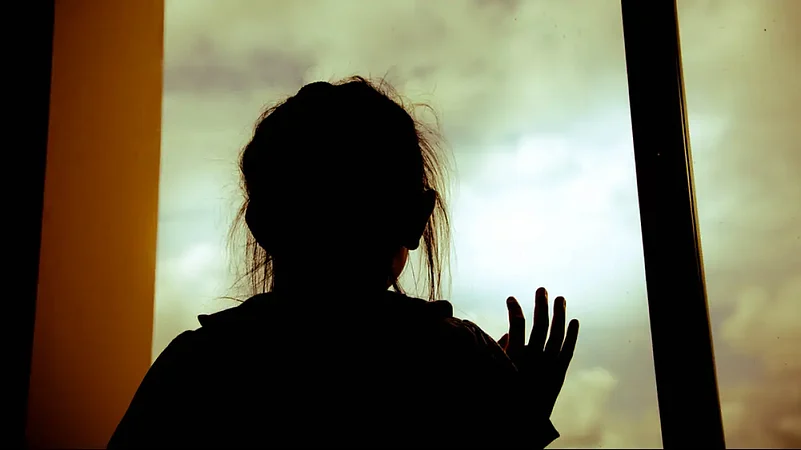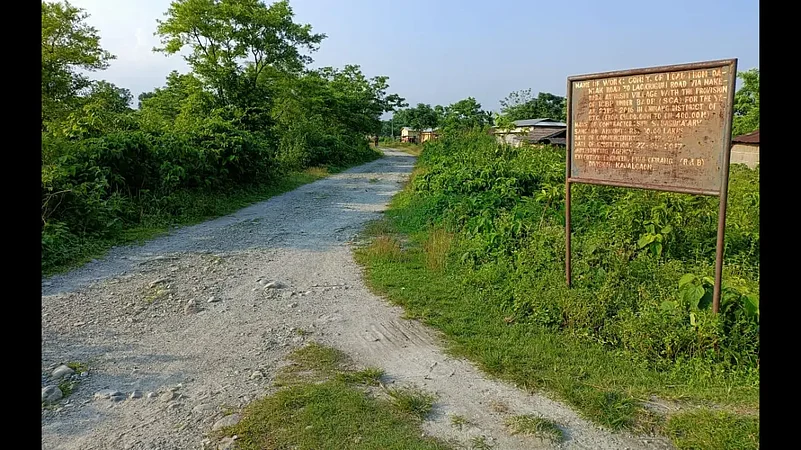Rimphali (name changed) was 13-year-old when she first saw her trafficker. A 35-year-old man came to her house in 2nd Aie Powali village in Chirang district of Assam and met her father.?The trafficker promised him Rs 2000 per month and school education for his daughter. Her father, a daily wage labourer, sent Rimphali along with the man with two pairs of clothes and one pair of new slippers. Jogi took her to Sikkim, a nearby state situated at a distance of about 408 km, and is connected via NH-27 from Chirang via Siliguri of Bengal.
Assam's Trafficked Children Await More Than Just Rescue
A total of 40 children were rescued by Assam police during a month-long operation whom Jogi lured with the promise of money and education. All of them were aged between 9 to 18 years and engaged as domestic help.

Jogi, who used to live in a nearby village of Raipur, however, did not get her enrolled in a school. Instead, Rimphali got a job --?as a domestic help in a family.
"She used to call us from Sikkim sometimes once a week or two. She said she cooks for the family and also babysits a toddler. She was not paid but was given food. Jogi gave us Rs. 1500 after six months of taking her,"?said Rimphali's?grandmother, an Adivasi woman in her sixties.
In June 2021, someone blew a whistle about Krishna Jogi, and about children getting disappeared from the border villages of Bodoland Territorial Region (BTR), an area of about 9000 square kilometres that comprise Chirang, Kokrajhar, Baksa and Udalguri districts. All these districts share an international boundary with Bhutan.
Acting on a tip-off, the Assam Police apprehended Jogi from his house and took him to Sikkim to locate the children he trafficked. A total of 40 children were rescued by the Assam Police during a month-long operation whom Jogi lured with the promise of money and education. All of them were aged between 9 to 18 years and engaged as domestic help.
During June and July 2021, when the nation was under lockdown, a total of 108 children trafficked from villages with Bodo and Adivasi populations were rescued by police?while many are still untraceable. These children were first kept in a Children's Home in Guwahati for a few months and later handed over to their parents. A few months later Jogi was released on bail.
However, three months ago, Rimphali again went missing from her home.
“Her employer came from Sikkim to Shyamthaibari and took her back again. She at times calls her father,"?said Murali,?a daily wage labourer.
Shymthaibari is the area in Chirang that intersects with NH-27 which leads to Bengal via the Kokrajhar-Serampore gate. From Bengal, Sikkim is a 4-hour-long road journey.
But why did she go again? Upon asking Murali, 61, points out to her courtyard. A big mark of animal foot was clearly visible from a distance of 30 ft.
“The Ganesh Baba visits us every day. Today also he came early in the morning. Luckily, I woke up and got the time to run away from the backdoor when he was standing in front of my house. How can children sleep in peace here? At least she is getting a proper house to stay in,"?she said.
By Ganesh Baba, Murali?refers to the elephants that visit these villages often in search of food. Many times they trample the houses down, destroy the paddy and kill humans, thanks to the massive deforestation and timber smuggling along the Assam-Bhutan border. In fact, Udalguri and Baksa districts in the foothills of Bhutan are the two worst affected districts in terms of human-elephant conflicts in Assam. According to government data, a total of 924 people lost lives in Assam in the past 10 years in such conflicts.

In the adjoining village of Laukriguri, the disappearance of a 10-year-old girl child has tensed the neighbours. According to neighbours, about 8 months back Bahadur Marda (name changed), the father, sold the child to traffickers.
“He (the father) hardly stays home. Comes for a day or two in a week and again vanishes. He doesn’t care about protecting his home from Ganesh Baba. He used to work in Bhutan but now we don’t know what he does,” said Rupali Magar, a neighbour.
Like Marda, the major source of income for these villages of Aie Powali, Raipur, Laukriguri and many others along the border was the country of Bhutan. Through the Gelephu entry gate, hundreds of men and women from these villages would enter the Himalayan kingdom daily at 9 in the morning. They would work as salesmen, vegetable sellers, construction workers, masons and domestic help. At 4 pm they would come back to India before the gate gets closed.
However, in March 2021, their lives came to a standstill when Bhutan sealed the international border due to the coronavirus pandemic?as at least one member from each of these families was working in Bhutan.
That closed gate opened another door for traffickers to enter these villages when the villagers were going through severe economic hardship.
“They first recce the houses of village people and try to find out if there were young girls and boys. Once they find out, they would befriend the family and then promise good education for their children. These villagers are innocent. They believe these people and send their children off. Only when the traffickers snap communication with the families or when they don’t get calls from their children, do they raise an alarm to the village headmen,” said Hirakjyoti Medhi, a local scribe from Chirang.
Advertisement
However, Rupali, the neighbour also wants to blame it on the illegal liquor selling in the region as to why her neighbour sold off his minor girl.

“Many people in the vicinity make local liquor and sell it secretly. You will find it in small shops inside the villages, or you can collect it from homes as well. The men in the villages send their children off to work or sell them to arrange for money to buy alcohol. He (the father) used to keep drinking all day and would not worry about his daughter”.
Advertisement
A major chunk of the population of the border villages in BTR?consists of internally displaced people from the Bodo and Adivasi community who were victims of multiple ethnic violence. The Bodos, a plains tribe, which had been fighting for a separate homeland carved out of Assam for more than three decades, often find themselves in friction with the Adivasi communities brought by the British. Hundreds got killed and lakhs got displaced in multiple clashes between 1996 and 2014. The displaced people started living in forest areas of the region.
Digambar Narzary, chairperson of NEDAN Foundation, a child rights NGO based in Kokrajhar district, agrees that Covid-induced hardship has increased the cases of trafficking. According to him the main reason for child trafficking in BTR, an area comprising about 9000 square kilometres, is because of the conflicts.
Advertisement
Talking to Outlook, Narzary says, “Many Children born in conflict areas and living in displacement in the BTR region are being sold in red light areas in nearby Siliguri, Kolkata and other parts of the country. There are at least 700 villages along the Assam-Bhutan border set up in forest reserves houses the displaced people. Children of these socially excluded communities are most vulnerable to trafficking as they don’t have access to education, health and their parents are very poor.” ?According to Narzary, around 2,72,000 people are living in unserved forest villages.
In 2021, NEDAN along with the help of Assam Police rescued 18 children from three districts of Chirang, Kokrajhar and Dhubri who were sold to the Khalpara red light area in Siliguri of Bengal. Narzary says every year 100-120 children are rescued by the NEDAN with the help of government authorities. These children are trafficked from Kokrjhar alone.
Advertisement
Another reason for trafficking in BTR according to Narzary is the lack of seats for higher education after the board exams. In 2021 in the BTR region, over 50,000 students passed the exam, but the capacity of the higher secondary schools to enrol them in class 11 in the region is only 25000.
“What will happen to the rest of 25000 children? What will they do without education? Every week, 50-60 children from BTAD are boarding the train to South India in search of work. What if they happened to fall into the wrong hands?”
Narzary, who has been working actively in the remote areas of the border to curb trafficking rehabilitation, and victim compensation since 2004 says another vulnerable section of the population to trafficking in the making are the orphans of the Covid pandemic in these areas.
Advertisement

After the rescue of the 42 children, Assam Chief Minister Himanta Biswa Sarma announced that as per the suggestion of the Child Welfare Committees, the decision of whether to send these children to their parents or to keep them in children's homes would be taken. While many children are sent back to their villages as part of the procedure, the case of Rimphali, the child who got re-trafficked to Sikkim, is a perfect example of why the state needs to do a lot more than just rescuing a child from the clutches of trafficking and come up with a workable rehabilitation plan.
Advertisement
Talking to Outlook, Pranjit Borah, Superintendent of Police, Chirang District said, “To prevent trafficking, the Child Welfare Committee, the NGOs need to penetrate more into the remote villages. Economic development and educational schemes should reach every house and police should be the last resort.”
Apart from the high infant and maternal mortality rate due to the lack of health centres, a major chunk of the population does not hold a ration card in these border villages.
Digambar Narzary feels that while core issues like education, health and economic developments need to be addressed, it is the communities that child protection committees need to involve in tackling the malice. For this purpose, Narzary’s NGO with the help of concerned authorities has created a network of 20,000 youths by forming Adolescent Clubs in the border villages to report and intervene in child trafficking with the help of the government. In 2012, he also created an SMS-ing system where locals can report trafficking to the NGO.
Advertisement
“The information is then sent to the nearest police outpost. In Kokrajhar district alone, a total of 62000 cases of child rights violations have been intervened so far.”
Notably, Child Line, a 24/7 telephone helpline for children in distress is yet to be operational in two districts of Chirang and Baksa.
In the Raipur village of Chirang, 45-year-old Madan Magar?is waiting for his daughter to come back home. “She should have told us that she does not want to stay in the village. We bought her books for her board exams by spending a lot of money. But she vanished," he said. His 15-year-old daughter left home on May 6.?
Advertisement
“Now she calls me from Delhi and says she likes the work in the shopping mall rather than sitting at home. Despite asking her repeatedly about with whom she went so far, she would not tell me. I myself would go and bring her back after I arrange the money for travel,” he sighs. Magar's case is pending with the police.
(Some names have been changed to protect their identity)
-
Previous Story
 Ex-Principal Grilled, Psychological Test For Accused: CBI Investigation Updates In Kolkata Doctor's Case
Ex-Principal Grilled, Psychological Test For Accused: CBI Investigation Updates In Kolkata Doctor's Case - Next Story


















